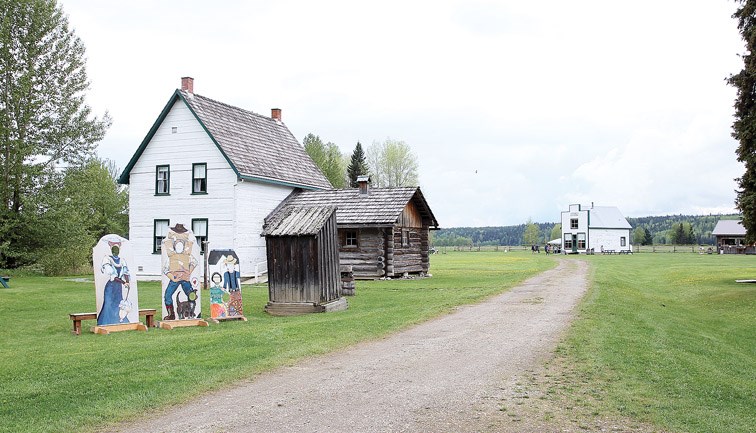History is making history.
Huble Homestead, the living museum on the site of the pioneer farm on the shores of the Fraser River north of the city, is about to open its gates for the new season.
This will be the 30th year those doors will swing wide for the public.
"We aren't shifting things up too much for the anniversary, but there is a comprehensive exhibit set up in the barn to show everyone how far we've come," said Krystal Leason, executive director of the Huble Homestead/Giscome Portage Heritage Society.
"Things that seem like they happened just yesterday were actually 10 or 12 years ago, as it turns out. That's what happens when you're around this long."
The actual homestead has been around since the turn of the 20th century.
It started with a farm and general store established in 1903 by business partners Edward Seebach and Al Huble.
Al and Annie Huble had two children by 1911, too many for the little cabin in which they lived. A proper house was in order, so the Hubles built one that year out of hand-hewn logs forming the picturesque structure still the centre of the museum grounds. It was modelled on the Ontario farmhouses of the time, out of keeping with the rougher local homes of the day.
A year later, the log store they had been operating got a similar upgrade. The fully operational store onsite today is a replica, based on photos and other documentation, opened in 1997 as a highlight of the museum.
The history of that general spot goes back much further, however.
Evidence of Aboriginal habitation of this region dates back at least 9,000 years and part of that ancient life was harvesting the bounty of the rivers.
A fish processing camp existed about two kilometres north of the homestead when Huble and Seebach lived there. A replica camp now exists at the museum to tie the Indigenous together with the newcomer settlers.
Even the location of the homestead was connected to First Nations knowledge. The Continental Divide is an invisible jagged line running imperceptibly from the top of the continent to the bottom across which waters are naturally drawn either to the Pacific Ocean or the Arctic/Atlantic Oceans. In 1862, prospectors John Robert Giscome and Henry McDame got caught at Fort George for the winter instead of their intended destination of Fort St. James.
The time they spent with local First Nations over that winter taught them about a shortcut, a portage from the Fraser River to Summit Lake that transitioned over the Continental Divide.
Travellers from the Pacific watershed could therefore easily switch directions to the northern/eastern watershed. Huble and Seebach deliberately built their business to capitalize on that spot, since Giscome and McDames successfully advertised the shortcut to other prospectors, traders and explorers of their day.
"The only reason they built there was that vital transportation link," said Leason.
"It's the oldest house in our district still on its original location. It's also not the typical house you'd see around the Prince George region at the turn of the 20th century. So it is a great place to go to get your feet wet with local history, a great jumping off point for the past 100 years of life in this area."
The museum has to wait for the spring melt each year before it opens its doors. It has to wait longer than most spots in the area since it is more northerly than the city and it is nestled in some shadows that keep the entry road inaccessible longer than the meadows.
Leason laughed that sometimes their opening weekend is conducted in sandals and some years in boots, depending on the unpredictable spring weather.
"We're doing pretty well with our readiness this year," she said.
"We often only have about two weeks to do our opening prep, from the time the snow melts to the time we officially open. We do a ton of maintenance, get a lot of stuff out of storage, set up displays, stock up the general store, train our summer staff, we still have a lot of stuff on the list, but we are in good shape. We are just packing it in. It's the same but different all the time, but that's so nice. There's a certain amount of routine but also a certain amount that's new and spontaneous."
For reasons of preservation as well as aesthetics, some of the main buildings will be getting fresh paint this year.
There is also a major restoration project happening on the staff cabin, which won't be overt to the public but Leason said the hard work of renovation partners Central Builders, Niven Contracting, Victory Paint, and onsite caretaker Mike Hardeman will mean behind-the-scenes efficiencies that will greatly improve the functionality of the museum.
The Historic Huble Homestead will officially open for the 2019 season this Saturday with a soft start, then into the introductory event - Spring On The Homestead - running Sunday and holiday Monday.
"You can have a relaxing afternoon, your dogs are always welcome on a leash, you can have guided tours, there are a lot of public events, it is great place to bring people from out of town, and admission is by donation," said Leason. Some special events do require preregistration.
The homestead is open seven days a week from opening to Labour Day Weekend closing. The hours are 10 a.m. to 5 p.m., admission by donation. (The suggested donations range from adults at $5, to children and seniors at $3, to families at $10.) The facilities can also be booked for special events like weddings, birthdays, family reunions, staff retreats and the like.
The Huble Homestead is located 40 km north of Prince George, six km off Highway 97 on Mitchell Road where a prominent sign guides the way.



